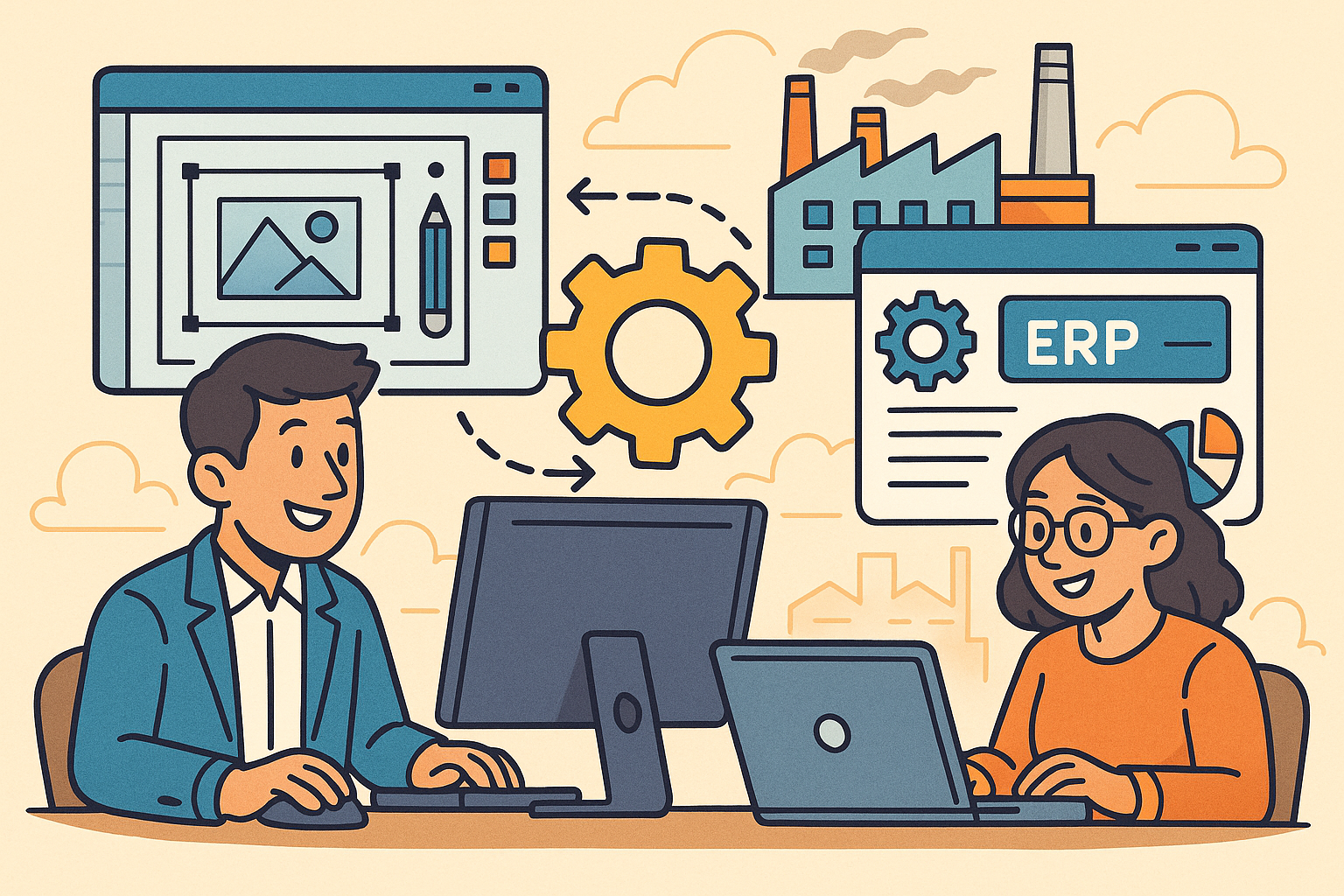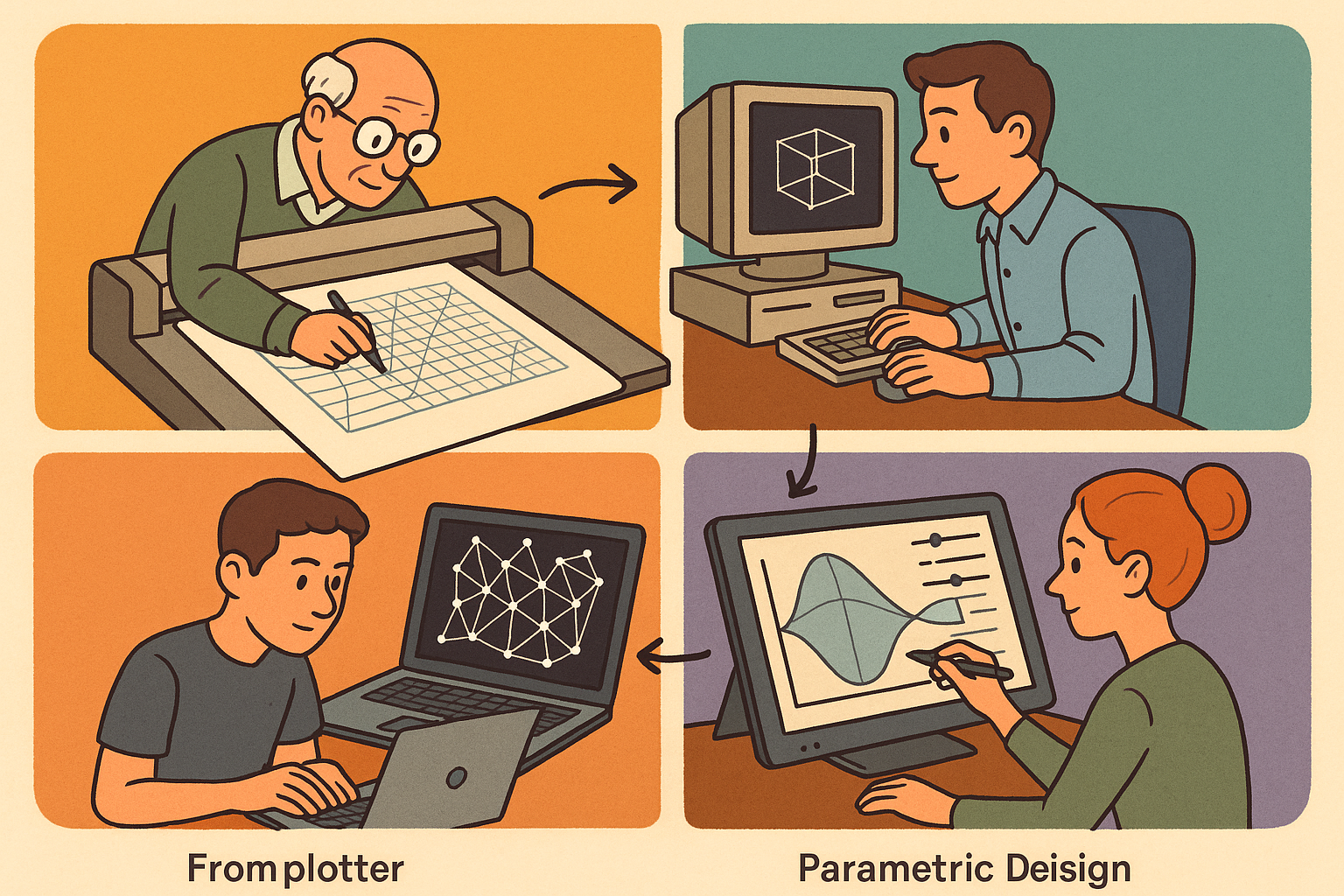Your Cart is Empty
Customer Testimonials
-
"Great customer service. The folks at Novedge were super helpful in navigating a somewhat complicated order including software upgrades and serial numbers in various stages of inactivity. They were friendly and helpful throughout the process.."
Ruben Ruckmark
"Quick & very helpful. We have been using Novedge for years and are very happy with their quick service when we need to make a purchase and excellent support resolving any issues."
Will Woodson
"Scott is the best. He reminds me about subscriptions dates, guides me in the correct direction for updates. He always responds promptly to me. He is literally the reason I continue to work with Novedge and will do so in the future."
Edward Mchugh
"Calvin Lok is “the man”. After my purchase of Sketchup 2021, he called me and provided step-by-step instructions to ease me through difficulties I was having with the setup of my new software."
Mike Borzage
Revolutionizing Business: Integrating Design Software with ERP Systems for Seamless Innovation and Efficiency
August 27, 2025 10 min read


Understanding the Integration
ERP Systems: Definitions and Core Functionalities
ERP systems represent a comprehensive framework designed to consolidate various business processes into a unified platform. These systems integrate functions such as finance, human resources, inventory management, and supply chain operations to produce accurate, real-time data that can be leveraged by decision makers. At their core, ERP systems provide businesses with the tools to standardize operations, enhance process visibility, and optimize resource allocation. By bridging the different areas of an organization, these systems minimize data silos and facilitate the smooth transfer of important information across various departments. The ability to capture, analyze, and disseminate critical data has become indispensable in today’s competitive environment. Industries ranging from manufacturing to retail have embraced ERP solutions to drive efficiency and agility. In addition to automation and improved reporting functions, ERP systems offer modular designs, enabling organizations to add new functionalities as their needs evolve. This comprehensive approach allows businesses to plan strategically while operating flexibly. Key benefits include enhanced operational efficiency, improved accuracy of financial reports, and the streamlined distribution of work. Furthermore, ERP systems encourage a culture of data-driven decision-making that supports continuous improvement. Enterprises that invest in these systems frequently experience a transformation in their operational dynamics, ultimately leading to competitive advantage backed by an integrative technological ecosystem.
Design Software's Role in Product Lifecycle Management
Design software is an essential tool in the realm of product lifecycle management, empowering teams to take a product from initial sketch to final market release with exceptional precision and efficiency. These advanced systems offer capabilities that include detailed 3D modeling, simulation, and stress testing of design prototypes, ensuring that each phase of the product development process meets both aesthetic and technical standards. This software allows designers to experiment with intricate models, validate complex geometries, and simulate physical behaviors—all of which reduce the need for repetitive prototyping. In today’s interconnected business climate, design software has transcended its traditional role and now integrates closely with operational systems like ERP software. This integration ensures that every design iteration is not only visionary but also aligned with production capacities and market requirements. Detailed digital representations and iterative improvements are communicated to production planners in near real-time, thereby fostering a seamless transition between creative conception and mass production. The impact of these connections results in shorter development cycles, lower production risks, and a bolstered rate of innovation. By aligning product design with business intelligence, companies are enabled to produce products that meet consumer expectations from both a functional and aesthetic perspective while maintaining robust control over underlying manufacturing processes.
Complementarity of ERP Systems and Design Software in Modern Enterprises
The convergence of ERP systems and design software embodies a holistic approach to managing both creative and operational aspects of a business. In today’s fast-paced market, this fusion provides enterprises with the ability to simultaneously address the artistry of design and the logistical challenges of production and resource management. With design software generating precise product models and simulations, ERP platforms take these outputs and integrate them with inventory management, procurement, and financial forecasting systems. As a result, every design update is supported by a corresponding adjustment in backend systems, ensuring that production details remain accurate and coherent. This synergy helps avoid costly errors, reduces redundancy, and fosters a culture of continuous improvement. Organizations can harness the interplay between these systems to accelerate innovation and streamline processes across all levels. The integrated approach enhances communication between disparate teams, leading to improved project management and better operational transparency. In addition, the timely exchange of information helps ensure that design modifications are practically implemented in production schedules without delay, thereby reinforcing the competitive edge of technology-focused enterprises. The combination of creative design prowess and structured business management establishes an environment where innovation is driven by efficiency, strategic resource use, and proactive decision-making—a compelling proposition in the digital age.
Key Integration Techniques and Technologies
APIs, Middleware, and Data Connectors: The Technical Backbone
Integration between design software and ERP systems relies heavily on the strategic use of APIs, middleware, and data connectors, which together create a robust technical backbone for seamless data exchange. APIs (Application Programming Interfaces) enable disparate software applications to communicate and share functions without exposing sensitive underlying code details. This standardized mode of communication ensures that both legacy and modern systems remain compatible during integration. Middleware functions as the intermediary layer between these systems, translating and routing data across various platforms to maintain consistency and reduce the need for custom integration strategies. Data connectors, on the other hand, facilitate the secure transfer of information by linking environments that would otherwise operate in isolation. Collectively, these tools help to achieve **real-time data synchronization** that supports dynamic interactions between design and operational systems. Businesses typically employ strategies such as:
- Implementing versatile APIs to bridge legacy systems with cutting-edge design platforms.
- Utilizing middleware to serve as an orchestrator for the flow of complex data.
- Employing data connectors that adhere to high security and compatibility standards.
Real-Time Data Synchronization and Cloud-Based Integration
The advancement of digital infrastructure has elevated the importance of **real-time data synchronization** and cloud-based integration strategies within the realm of system connectivity. Such integration ensures that any modifications made to design files are instantly communicated to the ERP system, and vice versa, thereby eliminating delays that could result in operational bottlenecks. Cloud-based integration provides the scalable infrastructure necessary to support these rapid data transfers while also ensuring that data repositories remain secure and accessible from virtually any location. This approach fosters enhanced collaboration across geographically dispersed teams and supports agile operations by enabling immediate visibility into system updates. Furthermore, the use of cloud environments minimizes the need for on-premises hardware and reduces maintenance overhead, all while delivering robust performance and reliability. With these mechanisms in place, integrated systems can deliver automated updates and centralized control that transform the dynamics of product development and supply chain management. The critical advantage is the minimal latency in data transmission—ensuring that design alterations, production schedules, and financial records are always in sync. As a result, these technologies not only boost operational efficiency but also empower organizations to respond swiftly to market trends and customer demands, thereby cementing their competitive advantage.
Implementation Strategies for Seamless Integration
Successfully implementing an integrated environment that connects design software with ERP systems requires a strategic blend of technological insight and careful planning. One of the primary methods is adopting a phased roll-out approach, which allows for gradual integration and provides ample opportunity to test each component individually. This incremental integration planning helps in isolating potential issues and addressing them before full deployment. A modular framework is another common strategy; by breaking down the overall integration process into smaller, manageable modules, organizations can systematically validate each section’s performance and compatibility. In addition, investing in middleware solutions and robust data connectors further simplifies the process, ensuring that communication between systems remains continuous and secure. Organizations have also found that adopting cloud-based tools enhances the speed and reliability of integration efforts by leveraging scalable infrastructure and **cloud-based integration** protocols. Supporting these advancements is a concerted focus on automation, reducing the risk of human error while accelerating overall performance. Best practices for a successful integration plan often include:
- Evaluating existing systems to identify high-priority integration points.
- Prioritizing API and middleware selections to facilitate communication.
- Implementing phased and modular approaches to minimize system disruption.
Benefits, Challenges, and Best Practices
Benefits of ERP-Design Software Integration
The integration of design software with ERP systems offers a host of benefits that fundamentally transform how organizations conduct their operations. One of the most compelling advantages is the **improved data consistency** across all facets of a business. With an integrated system, teams no longer need to reconcile discrepancies between isolated data repositories—every change made within design software is immediately reflected in planning, budgeting, and production systems. This synchronization leads to more efficient project management and resource planning; design updates align with procurement schedules and remain consistent with inventory records. Enhanced reporting and analytics further empower decision makers by providing a panoramic view of the entire product development lifecycle. The benefits also extend to increased agility, as rapid feedback loops enable businesses to quickly adapt to market shifts or necessary design modifications. Integrated systems reduce the manual burden on staff by automating the transfer of data, thereby driving down operational costs and error rates. Moreover, this unification of data facilitates a proactive approach to risk management, ensuring that potential issues are identified and addressed in real time. In summary, some of the key advantages include:
- Enhanced operational visibility and data integrity across departments.
- Streamlined workflows from design conception to production execution.
- Improved analytics that enable faster, data-driven decision-making.
Common Challenges in the Integration Process
While the integration of design software and ERP systems offers remarkable benefits, it also presents several challenges that organizations must tackle head-on. One major challenge is ensuring data compatibility, particularly when integrating modern, feature-rich design tools with established legacy ERP platforms. Legacy systems often utilize outdated data formats and protocols that are not inherently compatible with new software, creating a complex environment requiring extensive mapping and validation efforts. In addition to technical issues, security concerns demand significant attention. As data moves across various platforms, ensuring that robust encryption and secure data transfer protocols are implemented is of paramount importance to mitigate the risk of breaches or data loss. Furthermore, there is a significant human component to the integration challenge. The transition to an integrated system requires extensive training and a cultural shift as employees adapt to new workflows and technologies. Resistance to change, combined with the need for continuous support, can occasionally slow adoption rates. Common challenges therefore include:
- Data compatibility issues between legacy systems and modern software.
- Heightened security risks during data transfer and synchronization.
- The significant learning curve associated with mastering integrated system technologies.
Best Practices for Effective Integration
To fully realize the potential of an integrated ecosystem that combines design software with ERP systems, organizations must adopt best practices that ensure both smooth implementation and long-term operational excellence. One of the foundational best practices is to adopt an incremental integration approach. By rolling out the integration in well-defined, manageable phases, technical teams have the opportunity to validate each component of the system before progressing to the next stage. This minimizes the risk of systemic failures and allows for quick remediation of issues as they emerge. Collaborating closely with vendors from both the ERP and design software domains also plays a crucial role; their expertise is often instrumental in tailoring integration solutions to meet highly specific business requirements. Additionally, routine system testing and ongoing maintenance are critical for ensuring that both platforms continue to operate seamlessly as new updates and enhancements are released. Equally important is the need to provide extensive training and create robust feedback channels with end users. This ensures that operational staff can confidently navigate the new ecosystem and that encountered issues are rapidly addressed. Best practices commonly adopted include:
- Implementing phased integration planning to reduce risk.
- Establishing close partnerships with software vendors for expert support and continuous updates.
- Maintaining rigorous testing schedules and comprehensive training programs for all users.
Conclusion
Recap of Integration Significance
In summary, integrating advanced **design software** with comprehensive **ERP systems** marks a pivotal shift in how modern enterprises operate. This integration not only links creative product development with critical business operations but also results in an uninterrupted flow of data that drives uniformity and reliability across the board. The seamless communication between detailed design outputs and strategic back-end functions such as inventory management, finance, and production planning ensures that every change in design is efficiently mirrored in business processes. This results in significant benefits that include enhanced data consistency, streamlined project management, and superior analytics for real-time decision-making. The ability to fuse creative innovation with disciplined operational oversight constitutes a central pillar for achieving operational excellence. As companies increasingly operate in a digital and globally connected marketplace, the value derived from such integration continues to grow. With enhanced process transparency and a robust framework that supports agile responses to market trends, businesses are better positioned to leverage emerging opportunities and maintain a competitive advantage. This integration acts as a catalyst for transforming traditional workflows into dynamic, interrelated processes that support continuous innovation, responsive planning, and sustainable growth across diverse industries.
Strategic Outlook and Ongoing Adaptation
Looking forward, the strategic integration of design software with ERP systems is more than a mere technological upgrade—it is a long-term commitment to creating a future-ready enterprise. As systems continue to evolve, maintaining an integrated environment requires continuous adaptation and iterative improvements. Organizations that prioritize a robust integration strategy benefit from an operational model where every product iteration is supported by validated data across the board. In turn, this leads to accelerated product development cycles, higher operational accuracy, and the ability to swiftly adapt to novel market dynamics. The adoption of advanced integration strategies, including **cloud-based integration** and automated data synchronization, reinforces an enterprise’s capacity to adapt to technological changes. As business challenges become increasingly complex, the imperative to maintain a cohesive and adaptive system architecture becomes even more critical. Companies that proactively refine their integration approaches will be well equipped to respond to rapid technological shifts and evolving consumer expectations. Through a combination of continuous training, system updates, and strategic collaboration with technology providers, organizations can ensure that their integrated systems remain reliable, secure, and aligned with emerging industry trends.
Future-Proofing the Enterprise Through Integration
Ultimately, the journey toward fully integrated operations between design software and ERP systems is a strategic investment in future-proofing the enterprise. By establishing a robust framework that enables the seamless exchange of data and functionality, companies forge an environment that not only meets immediate operational needs but also adapts effortlessly to future technological demands. This integration empowers businesses to harness the strengths of both creative design and systematic resource management, resulting in a dynamic, responsive, and highly productive ecosystem. The ongoing evolution of integrated technologies necessitates a willingness to continuously update and refine systems, ensuring that they remain at the forefront of industry standards. Organizations that embrace this forward-thinking approach will enjoy benefits such as reduced operational complexities, enhanced agility, and a resilient infrastructure capable of thriving in an ever-evolving market. Through persistent innovation, rigorous testing protocols, and strategic vendor collaboration, enterprises cultivate a culture of excellence that drives sustainable growth and competitive advantage over the long term. In this context, integration is not just a technological challenge—it is a strategic journey that transforms conventional business operations into agile, data-led environments that consistently respond to and anticipate market change.
Also in Design News

Design Software History: From Plotters to Procedural Intent: A Technical History of Generative and Parametric Design Software
January 04, 2026 13 min read
Read More
Semantic Meshes: Enabling Analytics-Ready Geometry for Digital Twins
January 04, 2026 12 min read
Read MoreSubscribe
Sign up to get the latest on sales, new releases and more …



